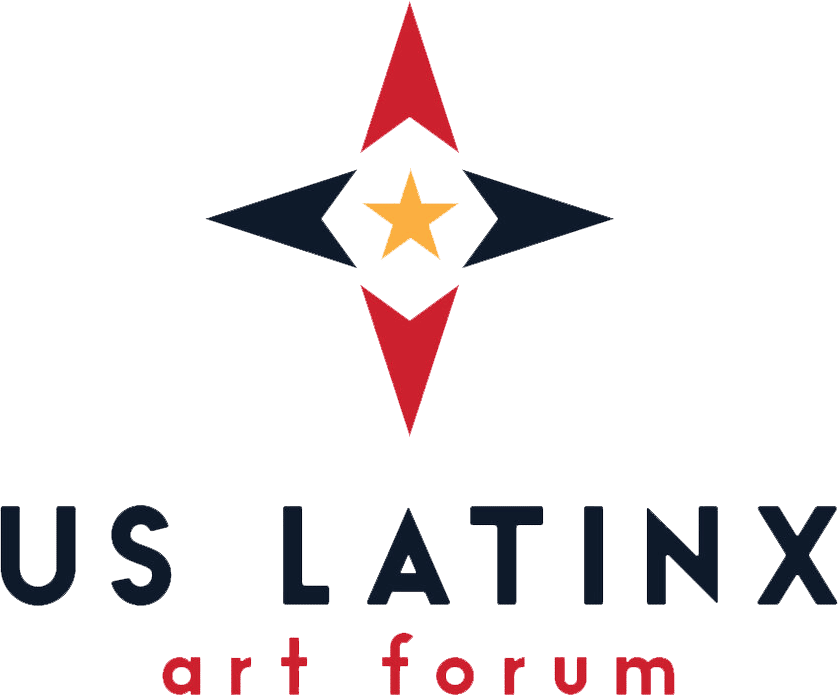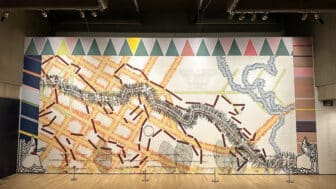
Table Remains: Sites of Discipline and Alternative Empathies, or an Invitation for Found Object Transformation
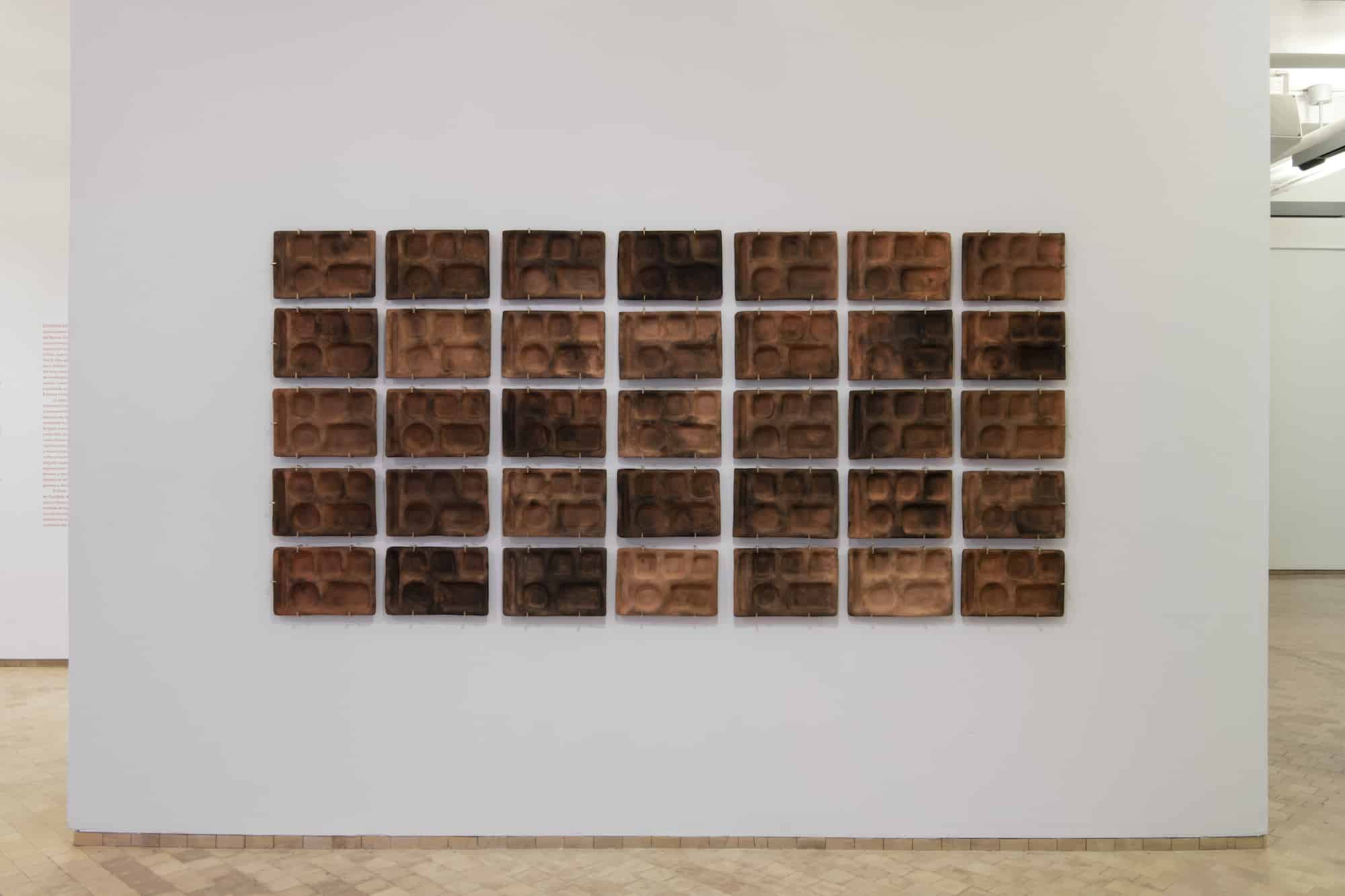
The first iteration of Table Remains by Vick Quezada (they/them) consists of 35 pit-fired ceramic cafeteria tray facsimiles that are molded from slabs of clay pressed into found metal trays and mounted on a wall in a grid of five by seven trays. The locked grid arrangement and scorched shades of brown resemble fired bricks or tiles, suggesting a built space of confinement. Scholars Lisa Lowe and Kris Manjapra, who discuss the relationship between objects and history, suggest that “the artifact appears to abbreviate the whole course of history into a finite object, while simultaneously refusing to yield this infinite multiplicity.” 1 In other words, objects are not stable. Over time, as they are created, used, and moved, they take on different meanings, and at any point, these meanings can be subverted by their user. Every object suggests its own entangled histories while offering new possibilities. Quezada intervenes, co-opting found objects and shifting their meaning through transforming them into clay.
Each of the three iterations of the ongoing series Table Remains connect with historical memories of institutions and personal memories of family. Cafeteria trays serve as metonyms for sites of discipline—schools, detention centers, and prisons. Quezada found the original tray for the first in the series at a thrift store, where they continually return to connect their own stories with objects’ memories. 2 The small compartments, which suggest portions for a child, evoked their mom’s elementary school experience: From 1918 to 1969 the state of Texas banned the use of Spanish in public schools. 3 Quezada’s mother attended elementary school before 1969, and was disciplined with corporal punishment for helping another student who spoke only Spanish. Her father—Quezada’s grandfather—who had been assimilated through the military, used to say “if you break the rules, you pay the consequences.” 4 In that short quip, he reinforced the promise that both military enlistment and formal schooling offered greater enfranchisement in exchange for acculturation. The intergenerational memory of this event emerges through the clay body, fusing human and geologic memory.
The second set most resembles the original trays, with their gray metallic sheen. To achieve the illusion of metal, Quezada used palladium silver glaze to finish the pieces. This set is also arranged in a two-by-five pattern, but each segment of the tray has harder edges and sharper corners, forming trapezoids and pointy triangles. Quezada found the tray on eBay, another place where they search for objects. It was from a military base in Fort Hood, Texas—the same base where their relatives were stationed. 5
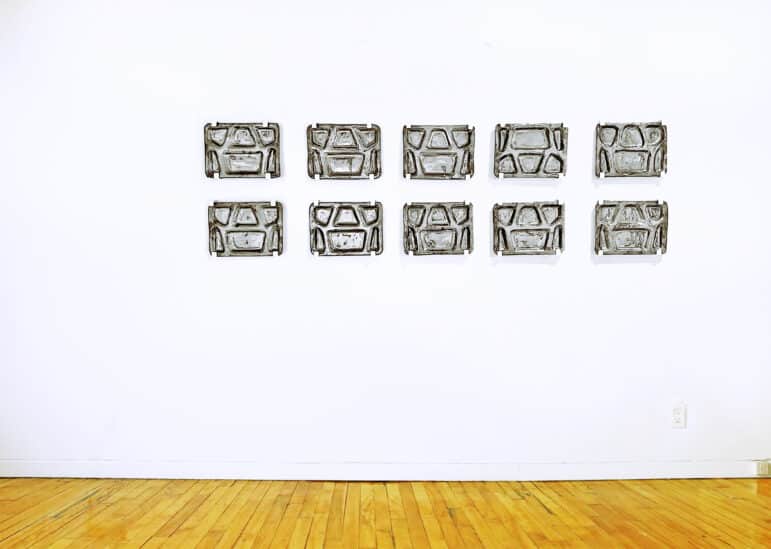
overall approx. 25 × 87 1/2 in.
On loan to Ruiz-Healy Art in San Antonio, Texas.
The third set in the series Quezada molded from trays is from a US Immigration and Customs Enforcement (ICE) detention facility, a site for detaining noncitizens while they wait for immigration court proceedings or deportation and where one of Quezada’s family members worked. 6 A collection of smaller trays, also laid out in a two-by-five grid, consists of white trays fixed into rigid order on the white wall. The trays themselves are squarer, with deeper troughs for food, suggesting adult mouths. Quezada glazed them a matte white, so they blend into the gallery’s ordering structure. The gallery space with its white walls is just another apparatus of discipline, directing visitors to move and behave in a certain orderly way.
Quezada asks us to consider each of these three institutions—elementary school, detention center, and military base—as a site of discipline and assimilation where each tray represents one body that was ordered into a form as regimented as these walls of tray tiles. They draw from French philosopher Michel Foucault’s Discipline and Punish: The Birth of the Prison, where he analyzes how the modern prison system emerged through the disciplining of bodies by a network of modern institutions that included places as seemingly benign as hospitals and factories. 7 Using systems of observation and recording, these institutions regulate small aspects of a person’s body, movements, and actions, even imposing the correct use of the body in relationship with objects. Foucault writes that “discipline defines each of the relations that the body must have with the object that it manipulates.” 8 The existence of the cafeteria tray implies a correct use of the tray. The student, the soldier, and the detainee must collect their food in a certain way at a marked time, sit in a specific spot in a determined bodily position, and consume the food as prescribed.
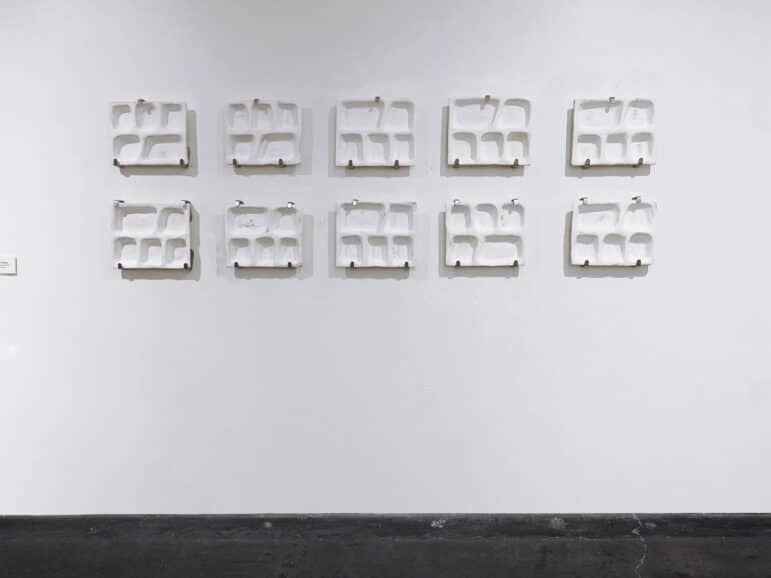
On loan to Ruiz-Healy Art in San Antonio, Texas.
By transforming the original tray into clay, Quezada subverts the disciplining intention of this object. Through Quezada’s own bodily engagement while molding clay, they form an intimate relationship with the plasticity, texture, and porousness of the clay. Quezada reworks memories held in the found objects into new objects that can simultaneously hold as symbols of the institutions they reference (through their shape and display) and as a connection point to pre-Columbian Aztec spirituality (through their clay material), where the earth, people, animals, plants, and all matter are interconnected. 9
Through Quezada’s process, they engage nepantla, a transitional space where negotiation and transformation are possible. Constance Cortez, art historian of Mayan and Chicano/a art, builds on Gloria Anzaldúa’s theorization of nepantla, defining it in relationship to contemporary art. Cortez describes nepantla as an Aztec word that refers to “a site of transformation, but one where the result of transformation is always secondary to the act.” 10 Process itself is the space of nepantla. The outcome is just an artifact of the growth that occurs during the process. Table Remains serves as another found object—another artifact—that layers Quezada’s experience over the object’s memories.
Though Quezada references the Texas–Mexico border with Table Remains, they source their clay from Sheffield Pottery in Western Massachusetts, closer to where they currently teach. Clay itself has its own deep temporal memory, connecting Quezada to the geologic history of the contested Mohican lands from which the clay is harvested. 11 The plasticity, color, and particle size of clay mined from the Sheffield property is unique to that geographic area. 12 Across a more-than-human time scale of millennia, the clay pit and clay properties emerged, determined by the climate, tectonic plate movement, and rock formation. At the end of an object’s life, the clay returns to the earth, broken down into dust.13
While clay is malleable and plastic in its unfired form, once fired, it vitrifies and becomes more like a glass object. It easily shatters when dropped. Quezada subverts the durable metal tray into a fragile clay version. In each iteration of Table Remains, the longer we look, the more irregular the trays become. For example, in the 35-tray version illustrated here, the pit firing process produces a broad range of color variation. Some of the trays are almost completely charcoal, while others are a light terracotta color. The forms, too, are slightly irregular, and the edges are not perfectly straight. The irregularity and fragility disrupt the disciplining order of the arrangement.
Quezada writes about their desire to “generate alternative empathies that open paths for a new consciousness” in a feature of their work in Transgender Studies Quarterly. 14 New empathies function as a kind of future memory, created through the dialogue Quezada’s work prompts around gender and spirituality in the lives of Indigenous peoples precolonization. 15 The wisdom of those life worlds grounds us in the present, against our individualistic society of dispossession, classification, and binaries. Quezada puts out an intention for transformation. In response, through conversation, viewers can move toward a different way of being in relation with the world. 16
Returning to Cortez, she writes that “the questions that they [artists] pose allow us as viewers to reevaluate our own multiple positions.” 17 Here, I invite you, as an interested reader and viewer, to participate in Quezada’s process for yourself. Tap into your own memories through interacting with materials. Maybe you are about to leave for work or make dinner but save the attached instruction for when you have twenty minutes to play with these ideas.
Endnotes
- Lisa Lowe and Kris Manjapra, “Comparative Global Humanities after Man: Alternatives to the Coloniality of Knowledge,” Theory, Culture & Society 36, no. 5 (September 1, 2019): 43. ↩︎
- Quezada also draws on rasquachismo, a “brash and hybrid” sensibility or aesthetics of reuse. See Tomas Ybarra-Frausto, “Rasquachismo: A Chicano Sensibility” in Chicano Art: Resistance and Affirmation, 1965–1985, Theory, Culture & Society 36, no. 5 (September 1, 2019): 23–48, https://doi.org/10.1177/0263276419854795; and Ella Diaz, “A Genealogy of Rasquache and Camp: Luis Alfaro and the Royal Chicano Air Force,” ASAP/Journal 2, no. 1 (2017): 105–29, https://dx.doi.org/10.1353/asa.2017.0018, for further analysis of rasquache. ↩︎
- The passage of the Texas Bilingual Act in 1969 circumvented the previous ban. Richard J. Gonzales, “Texas Once Banned Spanish in Public Schools. Fort Worth Broke that Mold in 1969,” Forth Worth Star-Telegram, September 19, 2019. ↩︎
- Vick Quezada, personal communication with the author, August 12, 2024. ↩︎
- Quezada, personal communication with the author. ↩︎
- Quezada, personal communication with the author. ↩︎
- Michel Foucault, Discipline and Punish: The Birth of the Prison, trans. Alan Sheridan (New York: Vintage, 1995), part 4, “Prison.” ↩︎
- Foucault, Discipline and Punish 152–53, 167–68. ↩︎
- The complicated concept of teotl underlies Aztec philosophy and spirituality. In part, teotl refers to the unified totality of all things. For more on Aztec metaphysics see James Maffie, Aztec Philosophy: Understanding a World in Motion (Boulder: University of Colorado Press, 2014), 21-62; Miguel León-Portilla, Aztec Thought and Culture: A Study of the Ancient Nahuatl Mind, trans. Jack Emory Davis (Normal: University of Oklahoma Press, 1963), 62-104; and Peter Herman Sigal, The Flower and the Scorpion: Sexuality and Ritual in Early Nahua Culture (Durham, NC: Duke University Press, 2011), 1-29. Quezada, personal communication with the author. ↩︎
- Constance Cortez, “The New Aztlan: Nepantla (and Other Sites of Transmogrification),” in The Road to Aztlan: Art from a Mythic Homeland, ed. Virginia M. Fields and Victor Zamudio-Taylor (Los Angeles: Los Angeles County Museum of Art, 2001), 358, 367. ↩︎
- The Mohicans were forcibly removed by the US government following the 1832 Indian Removal Act. Indigenous lands can be searched on the map “Native Land Digital” in Native-Land.ca, https://native-land.ca/ ↩︎
- Claims to land by white settlers are often made through material resources such as clay. See R. Ruthie Dibble and Joseph Mizhakii Zordan, “Cherokee Unaker, British Ceramics, and Productions of Whiteness in Eighteenth-Century Atlantic Worlds,” British Art Studies 21, https://doi.org/10.17658/issn.2058-5462/issue-21/dibblezordan, for a longer discussion of the complicated relationship between clay bodies and Indigenous knowledge; and Sheffield Pottery, “Clay Production Cycle,” https://www.sheffield-pottery.com/pages/our-clay-production-and-raw-material-refining for an example of a contemporary claim to land by white settler potters. ↩︎
- Silica, which forms when stars explode, makes up to fifty percent of a clay body. In its non-crystalline form, silica is also found in our bodies, where it helps form collagen. Across our bodies, clay bodies, and the stars, are the same elements. NASA, “Exploding Stars Make Key Ingredient Found in Glass – NASA,” NASA, accessed August 19, 2024, https://www.nasa.gov/image-article/exploding-stars-make-key-ingredient-found-glass/ ↩︎
- Vick Quezada, “Cart No. 1, Monoecious Fruits, the Harvest of 1519,” Transgender Studies Quarterly 6, no. 4 (2019): 556–58, https://doi.org/10.1215/23289252-7771709. ↩︎
- On the development of the modern or colonial gender system, see Maria Lugones, “The Coloniality of Gender,” Worlds and Knowledges Otherwise, On the De-Colonial (II): Gender and Decoloniality, 2, no. 2 (April 2008): 1–17. https://doi.org/10.1515/9783839461020-002. ↩︎
- Quezada, personal communication with the author. ↩︎
- Cortez, “The New Aztlan,” 373. ↩︎
O.M. Comstock is a writer, curator, and researcher. Currently a PhD Candidate in art history at the University of Minnesota, they are working on a dissertation titled “Allen Fannin: Hand Spinning and Weaving, Nitty-Gritty Needs, and ‘The Black Craftsman Situation.’”
Cite this essay: O.M. Comstock, “Table Remains: Sites of Discipline and Alternative Empathies, or an Invitation for Found Object Transformation,” in X as Intersection: Writing on Latinx Art, April 28, 2025, accessed [DATE], https://uslaf.org/essay/table-remains-sites-of-discipline-and-alternative-empathies-or-an-invitation-for-found-object-transformation/
